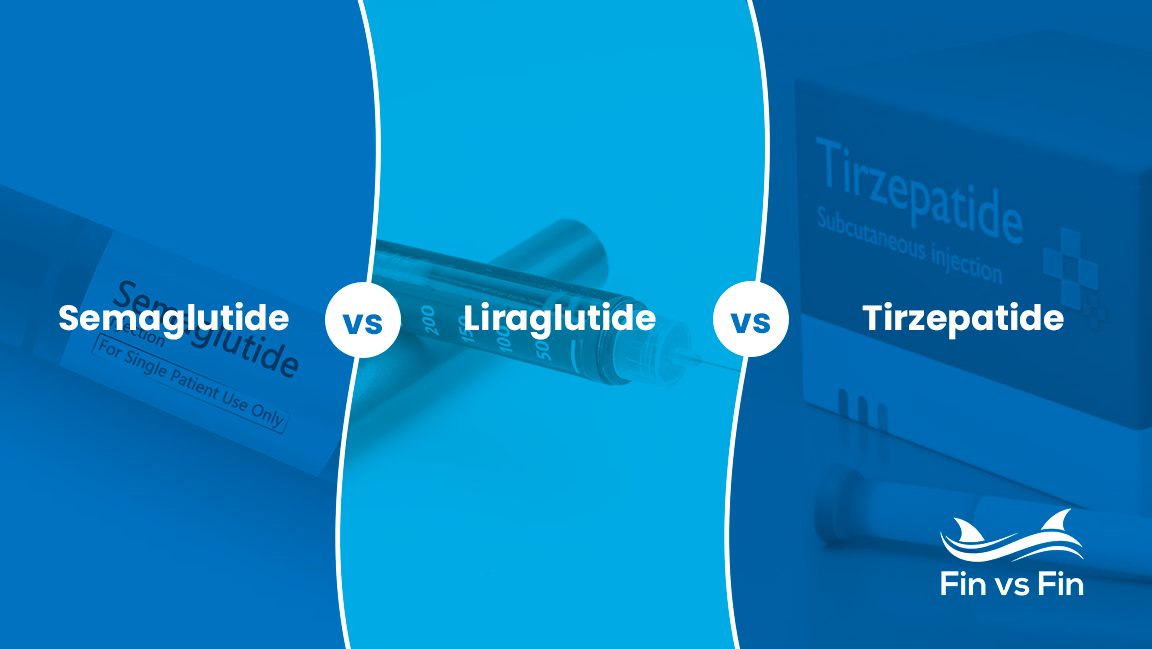- Tirzepatide may be more effective than semaglutide or liraglutide for weight loss, as it has a dual mechanism of action.
- Semaglutide has the longest half-life of the three, which may provide superior results for some people.
- Tirzepatide is the least expensive medication out-of-pocket; semaglutide and liraglutide are similar in cost.
- Side effects are similar between the three medications, but liraglutide is the most likely to cause psychiatric side effects.
Semaglutide (brand name Wegovy), liraglutide (Saxenda), and tirzepatide (Zepbound) are all glucagon-like peptide-1 (GLP-1) receptor agonists that effectively support weight loss. Though all three drugs are FDA-approved and work by blocking the GLP-1 hormone to reduce appetite, tirzepatide also blocks the glucose-dependent insulinotropic polypetide (GIP) hormone, which may provide an extra boost in weight loss for some individuals. Tirzepatide is also less expensive than semaglutide or liraglutide for individuals paying out of pocket.
Tirzepatide may be the most effective medication for weight loss, as it can provide a 15% to 20% reduction in body weight, compared to 10% to 15 % with semaglutide and 5% to 10% with liraglutide. However, these medications can work differently for different people, so it’s important to consult a licensed physician before making a decision.
In this article, we’ll compare semaglutide, liraglutide, and tirzepatide, specifically looking at their efficacy, dosage, cost, and side effects. We also spoke with a pharmacist, Dr. Tina Haroutunian, about the safety of GLP-1 drugs.

Comparison Chart: Semaglutide vs. Liraglutide vs. Tirzepatide
We directly compared semaglutide, liraglutide, and tirzepatide to help you determine which medication could work for you.
Semaglutide vs. Liraglutide vs. Tirzepatide | Semaglutide | Liraglutide | Tirzepatide |
|---|---|---|---|
| Average weight loss | 10-15% of your body weight | 5-10% of your body weight | 15-20% of your body weight |
| Eligibility | Adults with type 2 diabetes, obesity, or overweight with at least one weight-related condition BMI of 27 kg/m2 or higher | Adults with type 2 diabetes and BMI of 27 kg/m2 or higher with at least one weight-related condition Children aged 12-17 years with a body weight above 132 pounds (60 kg) | Adults with type 2 diabetes, obesity, or overweight with at least one weight-related condition BMI of 27 kg/m2 or higher |
| Dosage | 0.25mg to 2.4mg | 0.6mg to 3.0mg | 2.5mg to 15mg |
| Half life | 1 week | 13 hours | 5 days |
| FDA-approved? | ✅ Under the brand name Wegovy | ✅ Under brand name Saxenda | ✅ Under the brand name Zepbound |
| Administration method(s) | Subcutaneous injection, oral medication | Subcutaneous injection | Subcutaneous injection |
| How to take | Once weekly, any time of day, with or without meals | Once daily, any time of day, with or without meals | Once weekly, any time of day, with or without meals |
Semaglutide vs. Liraglutide
Semaglutide tends to be more effective than liraglutide, providing a 15.8% average weight loss, compared to 6.4%. It also has a much longer half-life, meaning that it provides much longer-lasting appetite-suppressing effects. Additionally, semaglutide is a once-weekly injection or pill, while liraglutide is a once-daily injection, making semaglutide more convenient. However, semaglutide and liraglutide are comparable in cost.
Semaglutide may be better than liraglutide for weight loss. The difference between semaglutide and liraglutide is that semaglutide is more effective for some individuals and more convenient to take.
Related reading: How to Get Ozempic (Semaglutide) Online for Weight Loss
Semaglutide vs. Tirzepatide
Studies show that tirzepatide is more effective than semaglutide for weight loss. Tirzepatide has a dual mechanism of action, so it works in multiple ways to support weight management. It’s also significantly less expensive for individuals paying out of pocket. However, semaglutide has a longer half-life than tirzepatide, meaning that it provides appetite-suppressing effects for longer.
Tirzepatide may work better than semaglutide for weight loss because it provides superior results for some individuals.
Related reading: How to Get Tirzepatide (Zepbound) Online
Liraglutide vs. Tirzeptide
Tirzepatide has shown superior results for weight loss when compared to liraglutide. It also has a significantly longer half-life, which may improve weight loss. Tirzepatide has a dual mechanism of action, which can further boost weight loss. Additionally, tirzepatide is significantly less expensive than liraglutide out-of-pocket.
Liraglutide isn’t better than tirzepatide for weight loss for some individuals, as tirzepatide has shown superior results in clinical studies.
What’s The Difference Between Semaglutide, Liraglutide, and Tirzepatide?
Semaglutide, liraglutide, and tirzepatide are all categorized as GLP-1 receptor agonists, meaning that they mimic the action of the GLP-1 hormone, which stimulates insulin. In mimicking the hormone, these medications lower blood sugar levels, curb hunger signals, and slow stomach emptying.
These drugs differ in effectiveness for weight loss, dosage, cost, and how long they take to work.
Related reading: Zealthy Weight Loss Review – Is It Legit for Ozempic and Wegovy?
Efficacy in Weight Management
Unlike semaglutide and liraglutide, tirzepatide has a dual mechanism of action. It’s a GLP-1 receptor agonist and a GIP, meaning it mimics both the GLP-1 and GIP hormones. GIP can induce insulin production and feelings of fullness, so tirzepatide may provide added weight loss support.
Semaglutide and liraglutide are GLP-1 receptor agonists and work exclusively by mimicking the GLP-1 hormone, leading to a reduced appetite.
Research notes:
- A 2023 study found that 15mg tirzepatide resulted in 17.8% weight loss, compared to 12.4% weight loss with 2.4mg semaglutide.
- A clinical trial comparing 2.4mg semaglutide and 3mg liraglutide (both with diet and exercise) found that semaglutide led to an average weight loss of 15.8%, compared to 6.4% with liraglutide.
- A 2023 study found that tirzepatide and semaglutide are significantly more likely than liraglutide to achieve a weight loss of 5% to 20% for obesity management in adults without diabetes.
Related reading: Henry Meds Semaglutide Review – Is It Legit for Weight Loss?
Patient Suitability and Eligibility
In individuals with type 2 diabetes, a 2021 study found that tirzepatide produced greater reductions in body weight than semaglutide. A 2021 study found that semaglutide more effectively reduced blood sugar levels than liraglutide and led to greater weight loss in people with type 2 diabetes.
Who Can’t Take Semaglutide, Liraglutide, or Tirzepatide?
Individuals with the following conditions are generally told to avoid GLP-1 agonists, including semaglutide, liraglutide, and tirzepatide:
- A history of medullary thyroid cancer
- A history of pancreatitis
- A history of gallbladder disease
- Multiple endocrine neoplasia syndrome type 2 (MEN2)
Additionally, GLP-1 agonists shouldn’t be used in combination with other GLP-1 agonists, insulin, sulfonylurea drugs for diabetes, or other weight loss medications.
How Long It Takes to Work
Some people may experience some weight loss within 4 weeks of starting semaglutide. However, the full effect can take several months. Clinical studies found that after 68 weeks, individuals lost between 9.6% and 17.4% of their initial body weight.
Tirzepatide can start to work for weight loss within a few weeks, but the final result is generally achieved after 72 weeks.
Liraglutide can produce some weight loss within 2 to 4 weeks, but it can take 56 weeks to see the final result. This makes liraglutide the fastest-working medication in this review, although it may produce less significant weight loss than semaglutide or tirzepatide.
Dosage
Semaglutide, liraglutide, and tirzepatide differ significantly in recommended dosage:
- The dosage range of semaglutide is 0.25mg to 2.4mg, taken orally or as a subcutaneous injection once weekly.
- The dosage range of liraglutide is 0.6mg to 3mg, taken once daily as a subcutaneous injection.
- The dosage range of tirzepatide is 2.5mg to 15mg, taken once weekly as a subcutaneous injection.
Tirzepatide has the highest dosage range, while semaglutide has the lowest dosage range. Despite this, clinical studies show that the medications have a similar incidence of side effects. One study found that 68.9% of individuals taking a 15mg dosage of tirzepatide experienced adverse effects, while 64.2% of individuals taking a 1mg dosage of semaglutide experienced adverse effects
Semaglutide and tirzepatide are once-weekly injections, while liraglutide must be injected once daily. Some individuals find this less convenient, and the need for daily administration can compromise treatment consistency.
It’s also important to note that liraglutide’s half-life is 13 to 15 hours, compared to 1 week with semaglutide and 5 days with tirzepatide. A drug’s half-life is the time it takes for the drug’s active substance in the body to reduce by half. With a dramatically shorter half-life, liraglutide can cause a more sudden and noticeable return of hunger signals, which may impact some individuals’ results.
Cost and Insurance Coverage
The cost of GLP-1 receptor agonists fluctuates, and the price can vary depending on the pharmacy and insurance plan. Additionally, the generic forms of these medications are often more affordable than the brand-name versions.
- A month’s supply of Wegovy can cost $950 to $1,400 out of pocket.
- A 6-week supply of Saxenda can cost $950 to $1,400 out of pocket.
- A month’s supply of Zepbound can cost $750 to $1,100 out of pocket.
Some health insurance plans provide full or partial coverage for Wegovy, Saxenda, or Zepbound. However, tirzepatide is the most affordable option for people paying out of pocket.
How to Obtain
Wegovy (semaglutide), Saxenda (liraglutide), and Zepbound (tirzepatide) are all FDA-approved for weight loss. Other brand names for these medications may be prescribed off-label for weight loss, including Ozempic (semaglutide), Victosa (liraglutide), and Mounjaro (tirzepatide). However, as these off-label drugs are formulated for diabetes management, not weight loss, they may not be as safe or effective.
To obtain semaglutide, liraglutide, or tirzepatide, you’ll need to undergo a consultation with a licensed healthcare professional. This may be done in person or through a telemedicine platform.
Related reading: Fountain GLP Review – How to Get Prescribed Semaglutide Online
Side Effects of Semaglutide, Liraglutide, and Tirzepatide
Semaglutide, liraglutide, and tirzepatide can all cause side effects.
The most common side effects of semaglutide include:
- Nausea
- Vomiting
- Abdominal pain
- Diarrhea
- Constipation
- Burping
- Heartburn
- Redness or rash at the injection site
The most common side effects of liraglutide include:
- Headache
- Constipation
- Heartburn
- Fatigue
- Runny nose
- Sneezing or coughing
- Difficulty urinating or pain/burning while urinating
- Redness or rash at the injection site
The most common side effects of tirzepatide include:
- Nausea
- Vomiting
- Indigestion
- Burping
- Constipation
- Diarrhea
- Fatigue
- Gastroesophageal reflux
- Redness or rash at the injection site
One study found that common adverse effects were mild to moderate for both tirzepatide and semaglutide. This study also found that serious adverse effects were reported in 5% to 7% of individuals taking tirzepatide, compared to 3% in the semaglutide group. A different study reported that the incidence of serious adverse effects in people taking liraglutide was 6.2%.
Psychiatric adverse events, including suicidal ideations, are a possible risk of GLP-1 agonists. One study noted that of the psychiatric adverse events reported between January 2021 and May 2023, 44.4% occurred with semaglutide, 53.2% occurred with liraglutide, and 2.3% occurred with tirzepatide. This indicates that tirzepatide may be the least likely to cause psychiatric adverse events.

A Word From Our Expert
— Dr. Tina Haroutunian
The most common side effects of GLP-1 agonists are digestive related; heartburn, constipation, diarrhea, and nausea. These side effects usually go away within a few weeks of starting therapy or increasing their dose. It is possible to switch to another medication in the class if one is causing unnecessary side effects. Since they are relatively “new” medications we don’t have much data on long term use in patients. No drug is a miracle drug so patients do need to modify their lifestyle with diet and exercise changes while taking GLP-1 agonists to see the biggest benefit."
Summary
Although semaglutide, liraglutide, and tirzepatide all work by blocking GLP-1 to curb hunger signals, tirzepatide may be the most effective for weight loss, with the potential to provide a 15% to 20% decrease in body weight. Semaglutide can provide a 10% to 15% decrease, and liraglutide can provide a 5% to 10% decrease. However, results can vary from person to person.
Tirzepatide is also the least expensive for individuals paying out of pocket, although prices fluctuate frequently. The risk of side effects is similar between the three medications, but liraglutide is the most likely to cause psychiatric side effects, like suicidal ideations.
To obtain a prescription for semaglutide, liraglutide, or tirzepatide, schedule a consultation with a physician, either in-person or through a telemedicine platform.
Frequently Asked Questions (FAQs)
Does everyone gain weight back after semaglutide?
Gaining weight back after semaglutide is common, but doesn’t occur in all individuals.
Can you lose weight on semaglutide without changing your diet?
Semaglutide produces weight loss by making it easier to consume fewer calories, so it only works if you reduce your caloric intake.
Is tirzepatide hard on kidneys?
Some studies indicate that tirzepatide can increase the risk of kidney damage in some people. However, other studies indicate that tirzepatide slows the progression of chronic kidney disease.
What’s the best semaglutide for weight loss?
Semaglutide is the active ingredient in Wegovy and Ozempic. However, Wegovy is FDA-approved for weight management, while Ozempic is not FDA-approved for weight loss.
Can you switch from liraglutide to semaglutide?
Yes, you can switch from liraglutide to semaglutide under a physician’s supervision. One study found that switching from daily liraglutide to weekly semaglutide significantly improved body weight and glycemic control.
Can you take Wegovy and Saxenda together?
No, you can’t take Wegovy and Saxenda together. Doing so is unsafe and may lead to serious complications.
Related Reading

How to Get Tirzepatide (Zepbound) Online
Tirzepatide, sold under the brand names Zepbound and Mounjaro, is a prescription medication that works for weight loss by reducing appetite and increasing satiety. Administered as a once-weekly injection, this medication requires a prescription from a licensed healthcare provider. You can obtain it from a

Hims Weight Loss Review – Are Alternatives to GLP-1s Worth It?
Hims Weight Management Overview Cost: $79 per month What’s prescribed: Metformin, topiramate, naltrexone, bupropionAdministration method: Oral tablets Potential side effects: Nausea, diarrhea, constipation, sleep issues FDA information: FDA-approved Insurance: Not required Trustpilot rating: 3.6 Try Hims → If you’re hoping to find treatment that supports

Henry Meds Semaglutide Review – Is It Legit for Weight Loss?
Henry Meds GLP-1 Weight Management Overview Cost: $297 per month (including medication) What’s prescribed: Compounded semaglutide Administration method: Injections Potential side effects: Nausea, constipation, diarrhea Who qualifies: People age 18-75 who qualify for weight loss/management medication Trustpilot rating: 4.7 Try Henry Meds → If you’ve

Found vs. Sequence: Which Is Better for Weight Loss?
Found and Sequence both prescribe glucagon-like peptide-1 (GLP-1) receptor agonist drugs, a class of medication that helps you feel fuller for longer, helping individuals who qualify lose weight. Losing weight can decrease your risk for certain long-term conditions, as well as improve your blood pressure,

PlushCare Weight Loss Review – Is It Legit for Ozempic, Wegovy, & Mounjaro?
PlushCare Overview Cost: $14.99 per month membership fee + out of pocket costs ($129 for first doctor’s visit, $99 for follow-ups), or free if covered by insurance Types of medications: Saxenda (liraglutide), Xenical (orlistat), Wegovy (semaglutide), Contrave (naltrexone), Mounjaro (tirzepatide), Victoza (liraglutide), Ozempic (semaglutide), and

Can Weight Gain and Fasting Impact Hair Health?
Key Takeaways Rapid or excessive weight gain can affect hair health. Inadequate nutrition during weight gain or fasting can lead to nutrient deficiencies that harm the hair. Hormonal imbalances resulting from weight gain may impact hair growth. Fasting can cause physical stress and elevate cortisol













